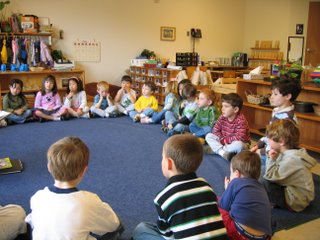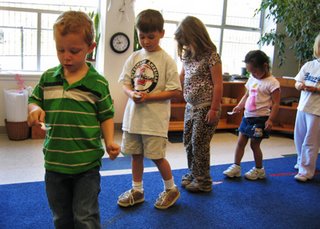Most Montessori classrooms have some sort of line time before, during, or after the work period.  Activities can vary, but they often include songs, lessons, and stories. Line time can be a powerful way for a group of children to build a sense of family – to really bond together. It builds community and gives a definite “beginning and ending” to the day.
Activities can vary, but they often include songs, lessons, and stories. Line time can be a powerful way for a group of children to build a sense of family – to really bond together. It builds community and gives a definite “beginning and ending” to the day.
Like most classroom activities, a little planning can make a big difference. Here are some great ideas for making the most of your line time:
Walking on the line
This activity is one of the core ways for Montessori students to develop balance and coordination. Typically, kids walk heel to toe, slowly, concentrating on keeping their feet on the line at all times. Playing music is a great way to signal line time without actually saying anything. As students hear the music, they will begin to put away their materials and rugs and start walking on the line until everyone is there. You can make this more challenging by having the children hold an object in their hands as they walk.
 I have a vivid memory of a 3-6 directress at a school where I worked, standing near the line with the Geometric Solids in a basket. As each child walked past her, she handed them one of the solids to carry until they were all used up. Then she walked over to the Pink Tower and began to hand those out one at a time. A child with much practice might even be able to carry the entire Pink Tower (or part of it) while walking on the line.
I have a vivid memory of a 3-6 directress at a school where I worked, standing near the line with the Geometric Solids in a basket. As each child walked past her, she handed them one of the solids to carry until they were all used up. Then she walked over to the Pink Tower and began to hand those out one at a time. A child with much practice might even be able to carry the entire Pink Tower (or part of it) while walking on the line.
Singing & musical instruments
-753264.jpg) Line time is an ideal time for music and movement. Children can suggest songs, or you can play CDs for them to sing along to. It’s nice to invite people into the classroom (parents, other teachers) to play instruments for the children.
Line time is an ideal time for music and movement. Children can suggest songs, or you can play CDs for them to sing along to. It’s nice to invite people into the classroom (parents, other teachers) to play instruments for the children.
If you give the kids their own musical instruments (usually rhythm instruments), try this for a challenge: let each child have a chance to choose their own instrument. The kicker is that they must say the name of it when they choose it. Ask that each child hold their instrument quietly until everyone has one. Another favorite music activity is having an adult or child tap a rhythm, and then all the other children try and echo it.
Stories & poems
Reading a story to the group is a nice way to begin or end line time. I’m always surprised by how much young children love hearing poetry read aloud. As the year progresses, older children can read books to younger ones, and children can recite poems to each other. One fun activity is to ask kids to stand up and tell a story – either a true story (like sharing about a family vacation) or a story that they make up on the spot. This is a chance to them to stretch their creativity as well as develop public speaking skills.
Group lessons
In Montessori 3-6, lessons are generally given on an individual basis determined by each child’s readiness. However, there are some lessons that actually work very well with the entire class together. One directress that I worked with would take the sandpaper letters off the shelf and pass them out around the circle. Then we would all say the sound of the letter as each child held them up in turn.
In elementary, lessons are often given to groups. Since math and language presentations are usually divided by grade, it’s the cultural presentations that work well with the entire class. Any kind of lesson from botany, zoology, geography, or history (or any of their subcategories) can easily be done for a group of multi-age children.
Care must be taken that all the kids can actually see the lesson. It helps to ask kids to have all their knees touching as they form a circle – that way no one is in anyone else’s line of vision. Take a deep breath before starting the lesson and ask everyone to keep their hands on their lap (or on their knees) and to remain quiet. During the lesson, don’t be afraid to stop and regroup if the kids get out of hand.
Making silence
Maria Montessori felt that this classic Montessori activity was the foundation for every other achievement. When a child quiets his or her body, they are preparing themselves for the act of concentration that makes work possible.
When making silence, children should have their legs crossed and eyes closed. Close your own eyes too! Let it stretch out longer than you think they can handle – they will always surprise you. Sometimes you may want to ask the children to share any faint sounds they heard while quietly listening.
Classroom maintenance & discipline
Line time is perfect for any announcements that need to be made about the day (special instructions or activities, for instance). For any age group, it’s nice to review the class ground rules at line time, especially at the beginning of the year. Attendance can also be taken at this time.
Elementary age classes can sometimes have behavioral issues that affect the whole class (for instance, a group of children that are making fun of another child). Addressing the matter in front of the group (without naming names) can be extremely effective. It brings the behavior out into the light, rather than keeping it a secret that some kids are afraid to talk about.
Thanks to Frida of Frida’s Fotos for the gorgeous line time pics!

